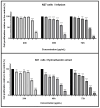Antioxidant, Phytochemical, and Pharmacological Properties of Algerian Mentha aquatica Extracts
- PMID: 39765840
- PMCID: PMC11673699
- DOI: 10.3390/antiox13121512
Antioxidant, Phytochemical, and Pharmacological Properties of Algerian Mentha aquatica Extracts
Abstract
Water mint (Mentha aquatica) is used in many formulations worldwide as a functional food and natural remedy to treat gastrointestinal disorders, lung diseases, and certain mental disorders such as epilepsy and depression. This study assessed the bioactivity of its infusion extract (INF) and hydroethanolic extract (HE) to highlight its health benefits. These extracts were analyzed for their chemical composition by HPLC-DAD-ESI-MSn, their antioxidant and antidiabetic properties, and their capacities to protect human erythrocytes against induced hemoglobin oxidation and lipid peroxidation. The effect on normal human dermal fibroblast (NHDF) cells and on the N27 rat dopaminergic neuron cell line was also assessed. The chromatographic analysis identified 57 compounds belonging to hydroxycinnamic acids, flavanones, flavone, and isoflavonoids. In respect to the biological potential, the Mentha aquatica extracts revealed a notable capacity for 2,2-diphenyl-1-picrylhydrazyl, nitric oxide, and superoxide radicals, as well as for the inhibition of α-glucosidase action and the protection of human erythrocytes against oxidative damage. Quantification revealed noteworthy phenolic content in both extracts. Additionally, the extracts demonstrated less cytotoxic effects regarding the NHDF and N27 cell lines. Overall, Mentha aquatica presents promising antioxidant activity and a spectrum of potential biological activities, underscoring its significance as a novel antioxidant candidate for applications in animal nutrition, human medicine, and natural product research in the pharmaceutical and nutraceutical industries.
Keywords: Mentha aquatica; antidiabetic; antioxidant; cytotoxicity; hemoglobin oxidation; lipid peroxidation; phenolic compounds.
Conflict of interest statement
The authors declare no conflicts of interest.
Figures




References
-
- Sezer F., Deniz S., Sevim D., Chaachouay N., Zidane L. Plant-Derived Natural Products: A Source for Drug Discovery and Development. Drugs Drug Candidates. 2024;3:184–207. doi: 10.3390/ddc3010011. - DOI
-
- Médail F., Quézel P. Hot-Spots Analysis for Conservation of Plant Biodiversity in the Mediterranean Basin. Ann. Mo. Bot. Gard. 1997;84:112–127. doi: 10.2307/2399957. - DOI
-
- Macheroum A., Kadik L., Neffar S., Chenchouni H. Environmental Drivers of Taxonomic and Phylogenetic Diversity Patterns of Plant Communities in Semi-Arid Steppe Rangelands of North Africa. Ecol. Indic. 2021;132:108279. doi: 10.1016/j.ecolind.2021.108279. - DOI
-
- Ayangbenro A.S., Babalola O.O. Reclamation of Arid and Semi-Arid Soils: The Role of Plant Growth-Promoting Archaea and Bacteria. Curr. Plant Biol. 2021;25:100173. doi: 10.1016/j.cpb.2020.100173. - DOI
LinkOut - more resources
Full Text Sources
Research Materials
Miscellaneous

